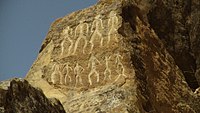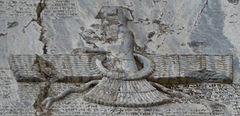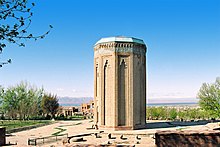Eldiguzids
Eldiguzids Atabegs of Azerbaijan اتابکان آذربایجان | |||||||||||
|---|---|---|---|---|---|---|---|---|---|---|---|
| 1136–1225 | |||||||||||
| Status | Atabegate | ||||||||||
| Capital | Nakhchivan Hamadan Tabriz | ||||||||||
| Atabeg | |||||||||||
• 1136 - 1175 | Eldiguz | ||||||||||
• 1175 - 1186 | Muhammad | ||||||||||
• 1186-1191 | Qizil Arslan | ||||||||||
• 1191-1210 | Nusrat al-Din Abu Bakr | ||||||||||
• 1210-1225 | Muzaffar al-Din Uzbek | ||||||||||
| History | |||||||||||
• Established | 1136 | ||||||||||
• Disestablished | 1225 | ||||||||||
| |||||||||||

| History of Azerbaijan |
|---|
 |
|
|
 |
| History of Greater Iran |
|---|
| History of Iran |
|---|
 The Gate of All Nations in Fars |
|
Timeline |
The Ildegizids,[1] Eldiguzids[2][3] (Template:Lang-fa) or Ildenizids, also known as Atabegs of Azerbaijan[4][5] (اتابکان آذربایجان Atabakan-e Āzarbayjan) were a Sunni Muslim Turkic[3] dynasty[6] (founded by Eldiguz of Kipchak[3] origin) which controlled most of northwestern Persia,[2] eastern Transcaucasia, including[2] Arran,[2][3][5] most of Azerbaijan,[2][3][5] and Djibal.[2][3][5] At their extent, the territory under their control, roughly corresponds to most of north-western Iran, most of the regions of modern Azerbaijan and smaller portions in modern Armenia (southern part), Turkey (northeastern part) and Iraq (eastern part). Down to the death in war 1194 of Toghril b. Arslan, last of the Great Seljuq rulers of Iraq and Persia, the Ildenizids ruled as theoretical subordinates of the Sultans, acknowledging this dependence on their coins almost down to the end of the Seljuqs.[2] Thereafter, they were in effect an independent dynasty, until the westward expansion of the Mongols and the Khwarazm-Shahs weakened and then brought the line to its close.[2]
Atabeg (literally means "fatherly lord" in Turkic) was the title conferred upon the Turkic officers who served as guardians of minor Seljuq rulers.[7] In the political circumstances of the time, Atabegs were not only tutors and vice-regents of their princes, but also de facto rulers.[7] At the height of Eldiguzid power, their territory stretched from Isfahan in the south to the borders of Kingdom of Georgia and Shirvan in the north. However, closer to the end of their reign amidst continuous conflicts with the Kingdom of Georgia, the Eldiguzid territory shrank to include only Azerbaijan and eastern Transcaucasia.[3]
The historical significance of the Atabeg of Azerbaijan lies in their firm control over north-western Persia during the later Seljuq period and also their role in Transcaucasia as champions of Islam against the Bagratids of Georgia.[3]
Shams ad-Din Eldiguz
In 1136, Sultan Ghiyath ad-Din Mas'ud (c.1134–1152) appointed Shams ad-Din Eldiguz (c.1135/36–1175) to be an atabeg of Arslan-Shah,[5] the juvenile successor of the throne and transferred Azerbaijan to his possession as iqta. Eldegiz chose Barda as his residence, and attracted the local emirs to his camp.
He made himself virtually independent ruler of Azerbaijan by 1146. His marriage with the widow of Sultan Toghrul II (1132–1133; Masud's brother and predecessor) afforded him to intervene in the dynastic strife which erupted upon Mas'ud's death in 1152. He succeeded, in 1160, in deposing Suleiman-Shah and installing his stepson Arslan-Shah (c.1160–1175) as a Sultan. Conferred with the rank of Atabeg, Eldiguz now became a chief protector of the Sultan's authority.[7]
The word Azam (meaning "great" in Arabic) was added to his title and he was also known as "Atabek-e Azam". All of the state's subsequent rulers used to hold this title. During his reign, Eldiguz could subdue a spacious territory between the Caucasus and Persian Gulf. The territory belonging to him stretched from the gate of Tbilisi up to Makran.[citation needed] He had possessed Iranian Azerbaijan, Arran, Shirvan, Jibal, Hamadan, Gilan,[citation needed] Mazandaran,[citation needed] Isfahan and Rey. The Atabegs of Mosul, Kerman and Fars as well as the feudals of Shirvan, Khuzestan, Ahlat, Arzan-ar-Rum and Maragha became his liegemen.
Campaigns against Georgia
Kingdom of Georgia, whose army was additionally strengthened by the Kipchak mercenaries, became the strongest rival of the Shams al-Din Eldiguz. In 1138, Georgian king Demetrius I, attacked the earthquake-ridden city of Ganja.[clarification needed] While leaving the city, his troops carried off the well-known gate of Ganja as their trophy, which up to this date remains on display at the Gelati monastery. From 1161 onwards Georgians began to make plundering raids on Ani, Dvin, Ganja, Nakhchivan and other regions controlled by Atabegs.
Eldiguz formed a coalition with other Seljuqids in the beginning of the 1160s to fight against the Georgians, and in 1163. the allies inflicted a defeat on king George III of Georgia. The Seljuqid rulers were jubilant, and they prepared for a new campaign. However, this time they were forestalled by George III, who marched into Arran at the beginning of 1166, occupied a region extending to faraway cities as Nakhchivan and Beylagan, devastated the land and returned with prisoners and booty. There seemed to be no end to the war between George III and atabeg Eldiguz. But the belligerents were exhausted to such an extent that Eldiguz proposed an armistice. George had no alternative but to make concessions. Eldiguz restored Ani to its former rulers, the Shaddadids, who became his vassals.
In 1173, Atabeg Eldiguz began another campaign against Georgia but he was defeated. Atabeg's troops retreated and Eldiguz died in 1174 in Nakhchivan.
Muhammad Jahan Pahlavan

After the death of Shams al-Din Eldiguz, in 1175, the Seljuq Sultan Arslan Shah tried to escape from the yoke of the Grand Atabeg of Azerbaijan but failed, and was poisoned to death by Shams ad-Din's son, the new Grand Atabeg Muhammad Jahan Pahlavan (c.1174–1186).[8] Pahlavan transferred his capital from Nakhchivan to Hamadan in western Iran, and made his younger brother, Qizil Arslan Uthman, the ruler of Azerbaijan. In 1174, Qizil Arslan captured Tabriz, which subsequently became his capital.[9]
Jahan Pahlavan suppressed all rebellious emirs and appointed faithful mamluks to key positions. He apportioned each of them any region or town as Iqta. The twelve years of his rule are considered the most peaceful period of the state's existence. Under his reign the central power was strengthened and no foreign enemy invaded the territory belonging to the Atabegs. Friendly relations with Khwarazm Shahs, the rulers of Central Asia, were founded. All those facts had positive influence on the development of science, handicraft, trade and arts.
Qizil Arslan

After Muhammad Jahan Pahlavan's death his brother Qizil Arslan (c.1186–1191) ascended the throne. He continued his successful struggle against the Seljuq rulers. At the same time the central power began to get weaker as mamluks who had strengthened their power in their allotments did not want to obey the Sultan. Even Shirvanshah Akhsitan I who used to be Atabegs’ liegeman attempted to intervene the interior affairs of the Eldiguzids and opposed Qizil Arslans aspiration to the throne. In the response to this, Qizil Arslan invaded Shirvan in 1191, reached to Derbent and subordinated the whole Shirvan to his authority. In 1191 Toghrul III, the last Seljuq ruler was overthrown by Qizil Arslan. Then, by Khalif’s leave, he proclaimed himself a Sultan.
The same year Qizil Arslan, who had become the sole ruler of the Great Seljuq Empire, was assassinated. The power was divided among his three sons: Abu Bakr, Qutluq Inandj and Amir Mihran. Abu Bakr governed Azerbaijan and Arran, and his brothers were the rulers of Khorasan and several neighboring regions. Soon, these three successors began to fight for the throne. Victorious in power struggle, Abu Bakr "Jahan-pahlavan" (c. 1195–1210) had his elder brother Qutluq Inandj assassinated and forced the younger brother, Amir Mihran, to take refuge at the court of the latter's brother-in-law, Shirvanshah Akhsitan I (c.1160-1196). The Shirvanshah together with Amir Mihran headed for Tbilisi, the capital of Kingdom of Georgia, and appealed for help to Queen Tamar of Georgia, an official protector of Shirvan. Received with great honors at the Georgian court, they were given desired support, and the Georgian army led by Consort David Soslan marched to Shirvan.
The Eldiguzid atabeg Abu Bakr attempted to stem the Georgian advance, but suffered a defeat at the hands of David Soslan at the Battle of Shamkor[10] and lost his capital to a Georgian protégé in 1195. Although Abu Bakr was able to resume his reign a year later, the Eldiguzids were only barely able to contain further Georgian forays.[11][12] The State's defense capability was stricken. Khorezmshahs' and Georgians’ non-stopping forays aggravated the situation in the country and speeded up its decay.
In 1209, the Georgian army laid waste to Ardabil – according to the Georgian and Armenian annals – as a revenge for the local Muslim ruler's attack on Ani and his massacre of the city's Christian population.[13] In a great final burst, the Georgian army led an army through Nakhchivan and Julfa, to Marand, Tabriz, and Qazvin in northwest Iran, pillaging several settlements on their way.[13]
Uzbek
After the death of Qizil Arslan, the power was divided among Jahan Pahlavan's sons, however, soon they started to fight for the throne. Abu Bakr came to the fortress of Alinja. The fortress, along with all the treasures, was at the disposal of Jahan Pahlavan's other widow, Zahida Khatun. Abu Bakr captures the fortress and the treasury. Qizil Arslan's nephews began to rule independently, and one of the Mamluks of Jahan Pahlavan, Mahmud Anas Oglu,freed Toghrul III from his prison and regains the sultanate throne in May 1192. However, soon after, in 1194, after a long war with the Khwarazm Shahs, Sultan Togrul III was defeated and the existence of the Iraqi Seljuk Sultanate came to an end.[1][6]
After defeated by Abu Bakr, Amir Amiran Omar went to gain a support from Shirvanshah Akhsitan I and Georgian Tsarina Tamar. In 1194, the united Georgian-Shirvan and Amir Amiran Omar's troops defeated Abu Bakr in the battles of Shamkir and Beylagan. Later, the Georgians trying to capture Ganja, temporarily occupied it, but soon Abu Bakr's troops drove the Georgians out of Ganja.[6] This process was speeded up during the reign of Atabeg Uzbek (c.1210–1225), who was enthroned after Abu Bakr's death. During his reign, the country was attacked by Mongols and Georgians.[6] In that period, Armenian prince Hasan-Jalal Dawla (founder of House of Hasan-Jalalyan cadet branch of Siunia dynasty[14]) (c.1215–1262) began his separatist activities, a fact which shook the fundamentals of the weakened State[citation needed]. In 1225, Khwarazm Shah Jalal-ad-din dethroned the Ildegizid Uzbek Muzaffar al-Din and set himself up in the capital of Tabriz on the 25 of July in 1225.[6]
List of Eldiguzids (Atabegs of Azerbaijan)
- Eldigüz (ca. 1135 or 1136-1174 or 1175)
- Muhammad Jahan Pahlawan, son of Eldigüz (1174 or 1175–1186)
- Qizil Arslan, son of Eldigüz (1186–1191)
- Qutluq Inandj, stepson of Muhammad Jahan Pahlawan (1191)
- Nusrat al-Din Abu Bakr, son of Muhammad Jahan Pahlawan (1191–1210)
- Muzaffar al-Din Uzbek, son of Muhammad Jahan Pahlawan (1210–1225)
Family tree
| Eldiguz ?-1175 Atabeg of Azerbaijan R.1136-1175 | |||||||||||||||||||||||||||||||||||||||||||
| Muhammad Jahan Pahlavan Atabeg of Azerbaijan R.1175-1186 | Qizil Arslan ?-1191 Atabeg of Azerbaijan R.1186-1191 | ||||||||||||||||||||||||||||||||||||||||||
| Nusrat al-Din Abu Bakr ?-1210 Atabeg of Azerbaijan R.1191-1210 | Muzaffar al-Din Uzbek ?-1225 Atabeg of Azerbaijan R.1210-1225 | ||||||||||||||||||||||||||||||||||||||||||
See also
References
- ^ a b Lewis, Bernard (1994). Sir Hamilton Alexander Rosskeen Gibb (ed.). Encyclopedia of Islam. Vol. 10. Brill. p. 554.
- ^ a b c d e f g h C.E. Bosworth, "Ildenizids or Eldiguzids", Encyclopaedia of Islam, Edited by P.J. Bearman, Th. Bianquis, C.E. Bosworth, E. van Donzel and W.P. Heinrichs et al., Encyclopædia of Islam, 2nd Edition., 12 vols. with indexes, etc., Leiden: E. J. Brill, 1960–2005. Vol 3. pp 1110-111. Excerpt 1: "Ildenizids or Eldiguzids, a line of Atabegs of Turkish slave commanders who governed most of northwestern Persia, including Arran, most of Azarbaijan, and Djibal, during the second half of the 6th/12th century and the early decades of the 7th/13th century". Excerpt 2: "The Turkish Ildenizids shared to the full in the Perso-Islamic civilization"
- ^ a b c d e f g h Bosworth, Clifford Edmund (1996). The New Islamic Dynasties: A Chronological and Genealogical Manual. Columbia University Press. pp. 199–200. ISBN 0-231-10714-5.
pp 199-200(Eldiguizds or Ildegizds): "The Elgiguzids or Ildegizds were a Turkish Atabeg dynasty who controlled most of Azerbaijan(apart from the region of Maragha held by another Atabeg line, the Ahamadilis), Arran and northern Jibal during the second half the twelfth century when the Great Seljuq Sultane of Western Persia and Iraq was in full decay and unable to prevent the growth of virtually independent powers in the province", pp 199-200: "Eldiguz (Arabic-Persian sources write 'y.l.d.k.z) was originally a Qipchaq military slave", pp199-200: "The historical significance of these Atabegs thus lies in their firm control over most of north-western Persia during the later Seljuq periodand also their role in Transcaucasia as champions of Islamagainst the resurgent Bagtarid Kings". pp 199: "In their last phase, the Eldiguzids were once more local rulers in Azerbaijan and eastern Transcaucasia, hard pressed by the aggressive Georgians, and they did not survive the troubled decades of the thirteenth century".
- ^ Hodgson, Marshall G.S. (1977). The expansion of Islam in the middle periods Volume 1. University of Chicago Press. p. 262. ISBN 0-226-34684-6.
- ^ a b c d e Luther, K.A. (December 15, 1987). "Atabakan-e Ādarbayjan". Encyclopedia Iranica. Retrieved October 28, 2010.
- ^ a b c d e Britannica. Article: Eldegüzid dynasty:
Eldegüzid dynasty, also spelled Ildigüzid, Ildegüzid, Ildegizid, or Ildenizid, (1137–1225), Iranian atabeg dynasty of Turkish origin that ruled in Azerbaijan and Arrān (areas now in Iran and Azerbaijan).
- ^ a b c Hodgson, Marshall G.S. The Venture of Islam: Conscience and History in a World Civilization, University of Chicago Press, 1974, ISBN 0-226-47693-6, p. 260
- ^ Antoine Constant. L'Azerbaïdjan, Karthala Editions, 2002, ISBN 2-84586-144-3, p. 96
- ^ Houtsma, M. T. E.J. Brill's First Encyclopaedia of Islam, 1913-1936, BRILL, 1987, ISBN 90-04-08265-4, p. 1053
- ^ Suny 1994, p. 39.
- ^ Luther, Kenneth Allin. "Atābākan-e Adārbāyĵān", in: Encyclopædia Iranica (Online edition). Retrieved on 2006-06-26.
- ^ Lordkipanidze & Hewitt 1987, p. 148.
- ^ a b Lordkipanidze & Hewitt 1987, p. 154.
- ^ Robert H. Hewsen. The Geography of Ananias of Širak: Ašxarhacʻoycʻ, the Long and the Short Recensions. — Reichert, 1992. — P. 194.
Literature
- Suny, Ronald Grigor (1994). The Making of the Georgian Nation (2nd ed.). Indiana University Press. ISBN 0-253-20915-3.
- Lordkipanidze, Mariam Davydovna; Hewitt, George B. (1987). Georgia in the XI–XII Centuries. Tbilisi: Ganatleba Publishers.
External links
- Encyclopædia Iranica, "Atabakan-e Adarbayjan", Saljuq rulers of Azerbaijan, 12th–13th, Luther, K.
- The history of Seljuq Turks from the Jami 'Al-Tawarikh: An Ilkhanid Adaptation of the Saljuq Nama of Zahir al-din Nishapuri. trans. and annoated by K. Allin Luther, e.d. by C.E. Bosworth (London, Curzon Press, 2001).
- Clifford Edmund Bosworth, The New Islamic Dynasties: A Chronological and Genealogical Manual, Columbia University, 1996. pp 199-200

